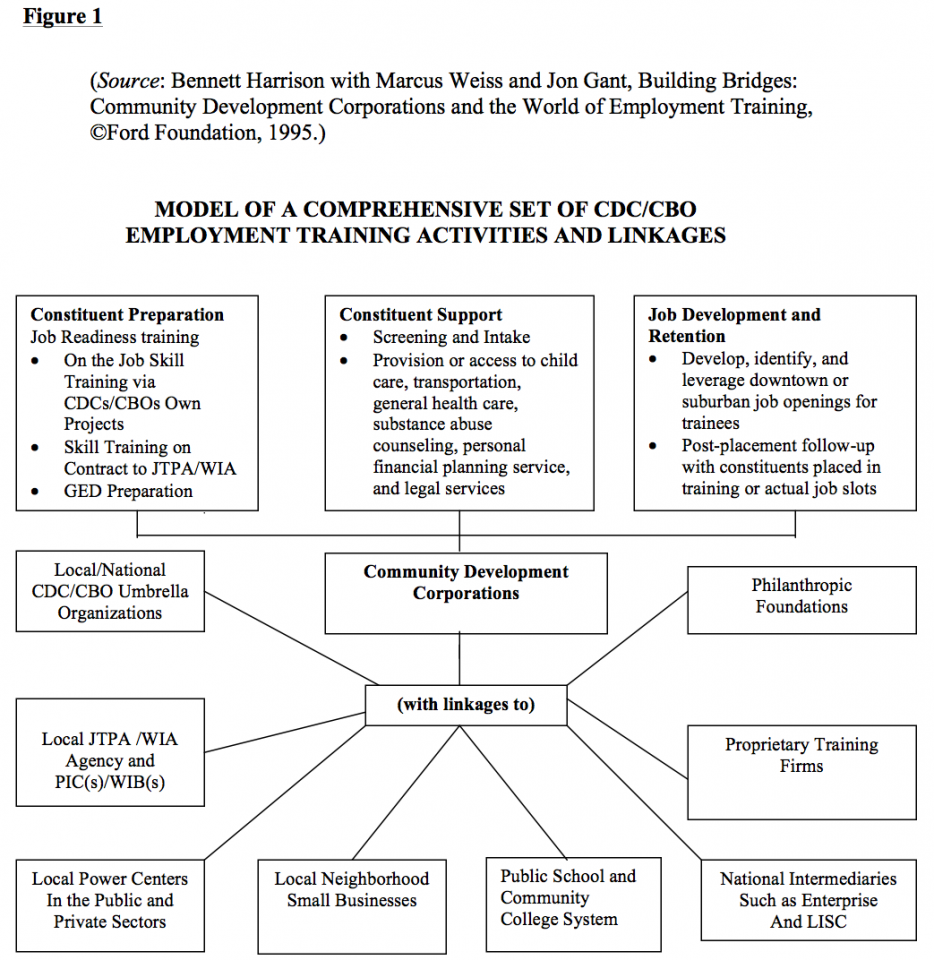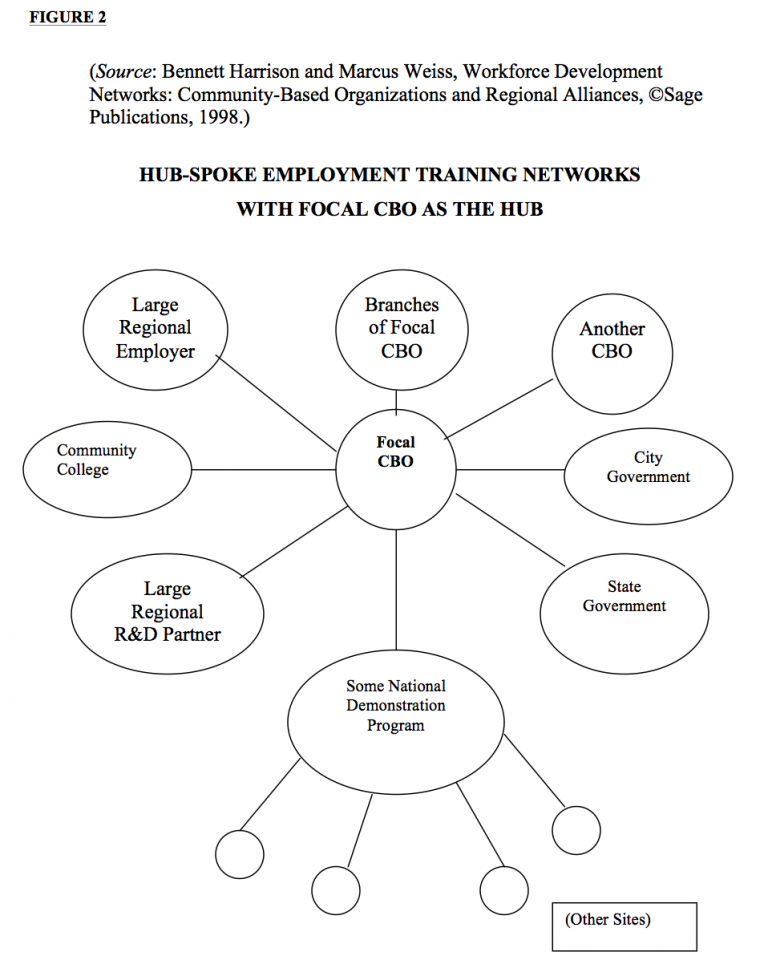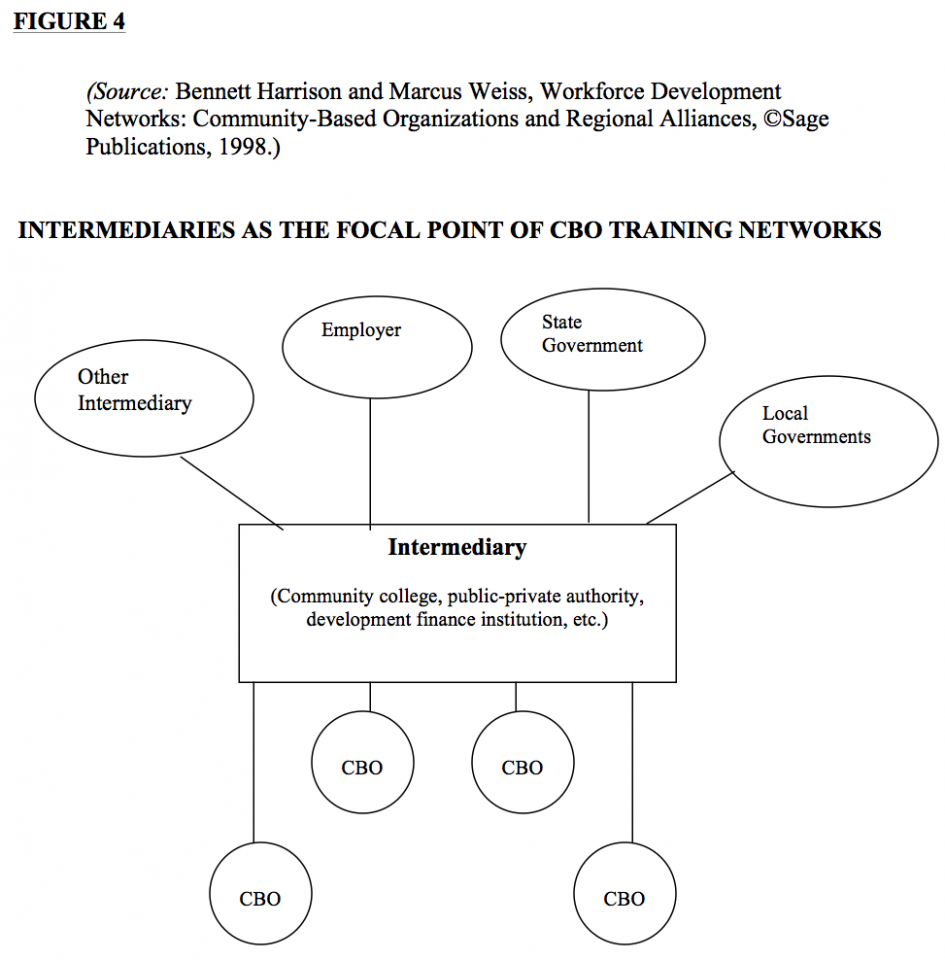Sections/excerpts from Marcus Weiss, “Regional Workforce Development Networks,” in Bridging the Divide: Making Regions Work for Everyone- Shaping the Federal Agenda, U.S. Department of Housing and Urban Development, Office of Policy Development and Research. Washington, D.C.
Excerpts from
Regional Workforce Development Networks
By
Marcus Weiss
Economic Development Assistance Consortium
Boston, Massachusetts
… organizations have also learned how to successfully engage in boundary-spanning, interregional networks to maximize the impact of their workforce development endeavors. Some groups emphasize manufacturing sectors while others focus on retail or service industry opportunities. Various organizations maintain internal capabilities to undertake training, placement and post-placement activities while others use the inter-organizational relationships they’ve acquired via networks to build collaborations with vendors or agencies to which they refer low-income, local residents. Most of these networking collaborators see workforce development as a “constellation of activities” ranging from world-of-work orientation, recruitment, training, placement, mentoring to subsequent counseling, direct support (e.g., loans for tools, transportation, uniforms, etc.) and human service interventions. (Harrison, Weiss and Gant, 1995)…

Shaping the Regional Agenda
As we attempt to “bridge the divide” and shape agendas which “make regions work for everyone”, support for boundary spanning networks becomes an important topic for decision makers at the federal, state, county and local levels. It is an equally essential subject for policy analysts, scholars, business leaders and representatives from the non-profit sector. Connecting left behind neighborhoods has become an essential part of public policy.
We all are cognizant of the declining share of job growth in core city areas in contrast to net job increases in metropolitan suburban communities. Governmental, business and community leaders recognize the need to improve approaches to extend prosperity and asset building to “new markets” and to residents of “economically challenged” communities. We are learning that workforce linkages to new jobs, brownfields reclamations and smart growth strategies are not just elements of enlightened government but are also important components for entrepreneurial endeavors to “thrive locally in the global economy”. Business leaders similarly have learned that it is in their best interest to engage with the public, community and philanthropic sectors to create core urban and regional settings that continually lure and retain “world class” companies while attracting newcomers and sustaining a high quality of life for all citizens. (Kanter, 1995) As we consider regional collaboration in an era of increased devolution, we need to reflect upon the fiscal, trade, regulatory and tax policies that are a necessary part of our modern economy. (McGahey, 1997)…


[divider top=”0″]

- Leveraging loans to businesses to obtain formal employment and training agreements (ETAGs)
- Creating business incubators with shared manufacturing equipment and other forms of operating support
- Networking local firms to other institutions in the regional economy such as banks, technology providers, shipping/transportation carriers, customs brokers, franchisers and communications companies
- Nurturing self-employment for local residents
- Creating supplier networks for neighborhood businesses with linkages to major manufacturers and governmental procurement programs
- Luring national retailers to commercial corridors in underserved communities
- Developing web site linkages between employers, training vendors and community entities capable of reaching low-income populations
- Connecting employers with less-frequently explored resources from governmental and philanthropic sources…
End Notes
- Harrison, Bennet with Marcus Weiss and Jon Gant (1995), Building Bridges: Community Development Corporations and the World of Employment Training. New York, Ford Foundation.
- Kanter, Rosabeth Moss (1995), World Class: Thriving Locally in the Global Economy. New York, Simon & Schuster.
- McGahey, Richard (1997), Economic Development, Devolution and Public Policy: Reforming Federal and State Policy in an Era of Global Competition, chapter in Rethinking National Economic Development Policy, Harrison and Weiss, editors (Economic Development Assistance Consortium). Washington, D.C., National Technical Information Service, U.S. Department of Commerce.
- Harrison, Bennett and Marcus Weiss (1998), Workforce Development Networks: Community-Based Organizations and Regional Alliances, Thousand Oaks, CA, Sage Publications.
Chapter from Bridging the Divide: Making Regions Work for Everyone- Shaping the Federal Agenda, U.S. Department of Housing and Urban Development, Office of Policy Development and Research, Washington, D.C.